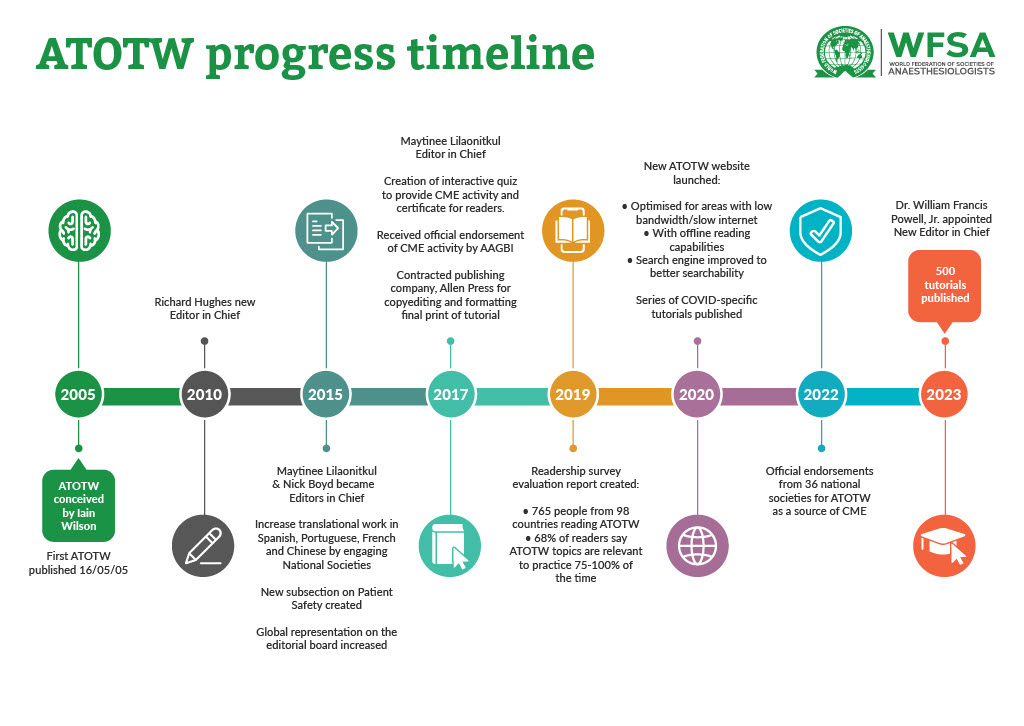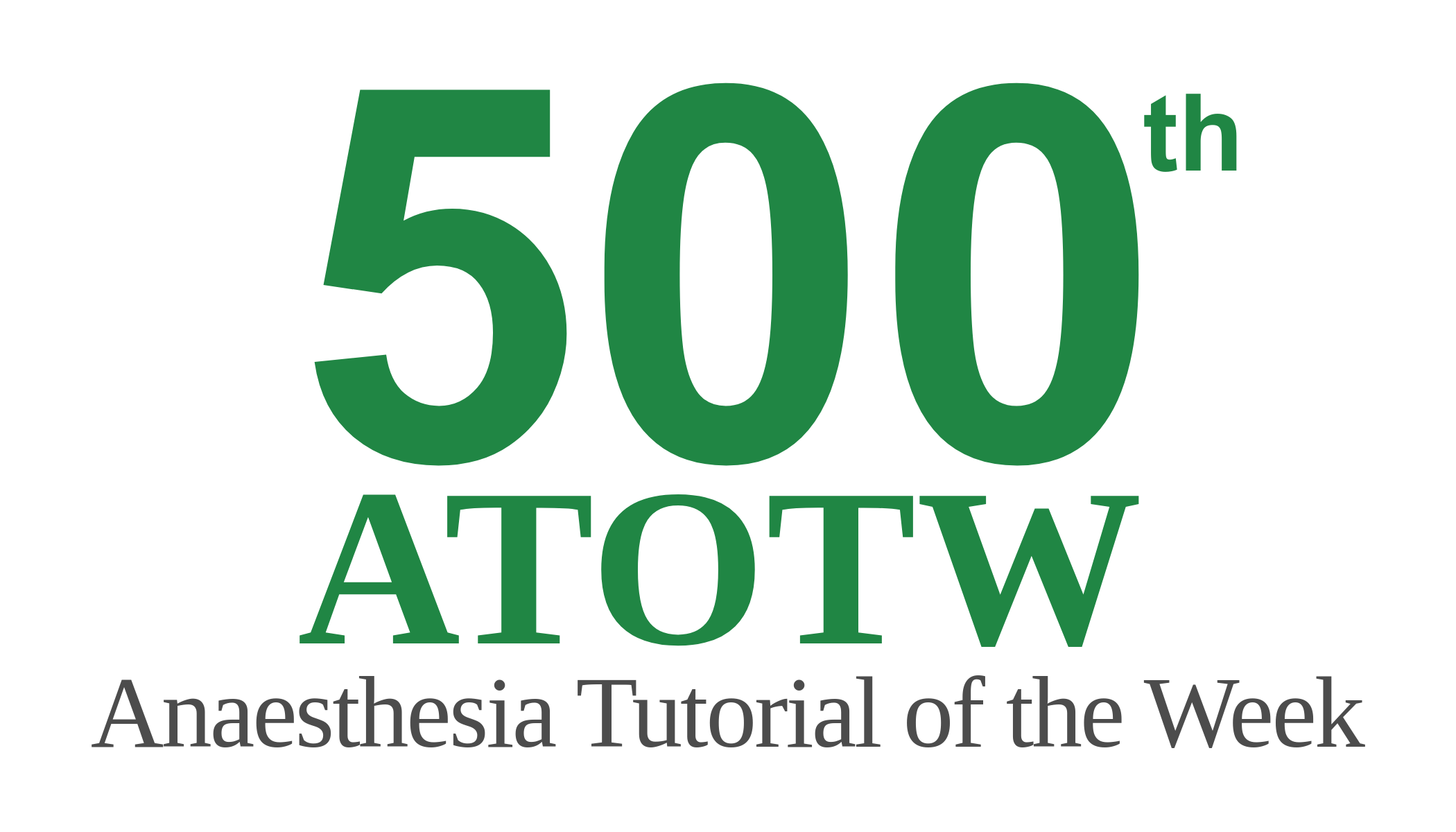On 6 July 2023, WFSA published the 500th edition of ATOTW. To celebrate this landmark, Editors-in-Chief (EiC) past and present discuss their roles in its conception, growth and longevity.
Iain Wilson, EiC 2005 – 2010
I worked in Zambia in the eighties where I trained a lot of anaesthesia officers and one of the problems was that they often had no books to learn from.
We developed a book distribution scheme with WFSA and AAGBI, but it was expensive and the books weren’t particularly relevant to the target audience. At that point, with the backing of WFSA I started writing and distributing Update in Anaesthesia.
My wife Carol was managing the distribution list and we were sending these out from the UK but it was still a very expensive and labour-intensive thing to do.

I was sitting on the train one day and it struck me that the advent of the internet and 3G email was becoming more popular and accessible. Clinicians were already online in their hospitals. The internet was the way we should be doing this.
I wrote the first tutorial of the week as an experiment in 2005 and posted it on the WFSA website. My idea was to create a library of tutorials that everyone had free access to.
We quickly realised that whilst we had primarily designed it for low-resource settings, due to the quality of the writing and resources people from high-income countries were also using it. It had a truly global audience.
It wasn’t until Maytinee took over as EiC that ATOTW really began to take off. She’s really the hero.
Iain Wilson
ATOTW is a remarkably efficient publication platform that is responsive to clinical needs. If someone identifies an area of interest, it doesn’t take much for them to go away find the content, and write and produce a tutorial which can be shared and used practically within a matter of months. It’s this simplicity of process that keeps content fresh and relevant.
After a few years, I handed over to Richard Hughes but it wasn’t until Maytinee took over as EiC that ATOTW really began to take off. She’s really the hero, she has taken it up a level, reorganising the editorial board and running with it.
My passion has always been free accessible high-quality education. If people are taught poorly at the start of their learning, it sets them up badly for their whole career. The aim has always been to enable people from all over the world access to the best education material written by experts and refined by experts ATOTW has achieved that.
Maytinee Lilaonitkul, EiC 2015 – 2023
As a trainee, I found ATOTW a fantastic resource, both as a practical clinical reference and for exam preparation. Towards the end of my training, I was offered the opportunity to become EiC. I felt very honoured and at the same time, daunted by the big task.
The intervening 8 years since that decision to take on the role have flown by. But my initial thoughts were right, it was not a small job.
Knowing first-hand the value of this resource, my priority as EiC from the start was to make ATOTW more globally accessible and representative.
StatisticsSince its launch, ATOTW has been accessed 3.7 million timesfrom 86 countries Top 5 ATOTW: 1. #455 – Anaesthesia for Caesarean Delivery—Best Practices 2. #480 – Scalp Block: Techniques and Applications 3. #471 – Basics of Mechanical Ventilation: 4. #478 – Pericapsular Nerve Group (PENG) Block – 5. #273 – Fisiología Renal – Parte I |
In terms of accessibility, we’ve made great strides with the online platform. Offline reading capabilities and considerate design have made it more accessible for people struggling with low bandwidth and intermittent internet connections. We’ve improved the visibility of ATOTW on search engines and the search functionality within the site itself, so it’s easier for users to find the subject areas that interest them.
We’ve also made it more representative of the global anaesthesia community. When I took over 90% of our editors and authors were from the UK (not surprising given it was founded there), Since then we’ve expanded our editorial board such that now it includes experts from Asia, Australasia, Europe and North and South America. Similarly, the authorship has vastly expanded and often includes collaborative work between anaesthetists from high and low-resource settings.
My priority from the start was to make ATOTW more globally accessible and representative.
Maytinee Lilanonitkul
We’ve translated it into more languages – tutorials are currently available in Chinese, French, Portuguese and Spanish.
And we sought to facilitate the CME accreditation process by featuring a quiz which enables users to earn a certificate that they can use to apply to their national society as a self-directed source of learning. Over 30 professional societies now officially endorse ATOTW.
Each tutorial is accessed by approximately 30,000 users. I think its growing popularity is due to its simple structure and clinical applicability. The bite-sized nature of ATOTW is vital. The tutorial is designed to be read and synthesized within an hour and then practically applied within the workplace. People are looking for something that contains high-quality peer-reviewed material. And above all, it’s free.
ATOTW is a volunteer powerhouse, it’s a labour of love from everyone involved. This fantastic group of volunteers – authors, editors, translators- give up so much time to provide the highest level and quality educational resource because they believe in the value of ATOTW and the impact that it makes.
I’m delighted that I’m handing over the editorial reins to Frankie Powell. He has the necessary passion, motivation and expertise to take ATOTW to the next level. ATOTW is in safe hands.
Frankie Powell, EiC 2023
I’ve been a paediatric anaesthesiologist at the Massachusetts Eye and Ear Hospital in Boston, US for coming up to 3 years.
I’m a long-standing fan of ATOTW having used and recommended it to all my co-residents and trainees whilst I was studying. I liked it because it was free but also peer-reviewed.
In 2020, I co-authored – ATOTW 417 Anaesthesia for Paediatric Laparoscopic Surgery
That tutorial was edited by Faye Evans who asked if I wanted to edit a couple of tutorials. I really enjoyed the editing as it was a good way to brush up on my writing skills as well as learn about a given topic.
I want to build the ATOTW community. We’re always looking for new topics, so if you would like to author a tutorial, my email address is on the website so please drop me a line.
Frankie Powell
After that, I was invited to become a regular editor for the paediatric subsection. Again, it was a really good experience, reaching out to potential authors and helping to identify new topics. After a couple of years of being a subsection editor, Faye recommended I apply for the Editor in Chief role.
I’m still learning the ropes, but it’s been a great experience so far. Connecting with the different subsection editors and learning about their backgrounds and interests.
I’m excited about building on what May has accomplished by continuing to grow ATOTW so as many people as possible can access and use this fabulous resource. Vital to this expansion is the CME component of ATOTW.
To do that I want to build the ATOTW community. We’re always looking for new topics, so if you would like to author a tutorial, my email address is on the website so please drop me a line.
I’m also looking to build the editorial team, so again if you are interested in helping shape this wonderful educational resource, please contact me.






